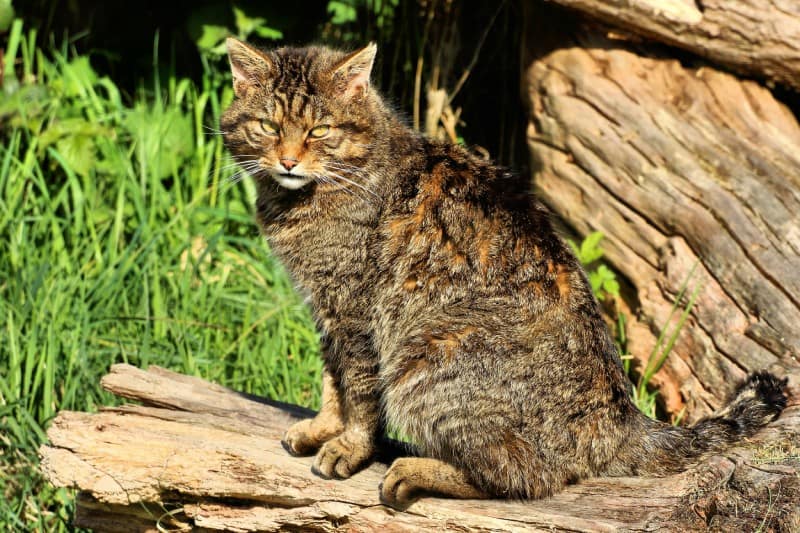Scottish Wildcat Facts
- First of all, the rather surprising Scottish Wildcat holds a very specific claim to fame, in a manner of speaking. That’s because it represents a variety of wild feline that virtually no one outside of its endemic range knows exists. That’s partly due to the fact that it strongly resembles a domestic feline.
- Furthermore, this rather adorable wildcat itself actually constitutes a subspecies of another variety of wild feline. That parent species is the equally little-known European wildcat. However, that species possesses a larger natural habitat range than the Scottish Wildcat.
- Sadly, like many related species, this animal also faces serious threats to its continued existence. Perhaps the most pressing is its extremely limited population. That’s because, at present, estimates place the total population of the animal at no more than 300 individuals, perhaps fewer.
- But it also faces other serious threats. Ranking high on this list is climate change and habitat loss, like many other species throughout the world today. Yet, the species also faces the added threat of interbreeding with domestic felines, given its small physical size.
Related Articles
Scottish Wildcat Physical Description
Perhaps most notably, the Scottish Wildcat has a rather striking appearance, to be certain. Nonetheless, it ranks as a rather small species of wild feline, compared to others. Like many animals, it also displays a moderate degree of sexual dimorphism. In its case, physical size represents the most obvious example of the principle.
Firstly, adult males of this mammal only attain an average weight of about 16 lb (7.2 kg). Meanwhile, the significantly smaller females only average a weight of about 10.3 lb (4.7 kg). Additionally, females of this fascinating wildcat generally develop slightly smaller skulls than males, in relation to body size.
But its physical size isn’t the only reason it can be confused with a domestic cat. It also bears a striking resemblance in terms of coloring. The coats have a tabby-like patterning, very similar to many domestic cats. However, it lacks the the white feet common domestic tabbies.
In addition, the tail grows comparatively thick, with a prevalent ringed pattern. But it does possess one decidedly unusual physical attribute. Uniquely, and rather interestingly, the ears of this feline have the ability to rotate a full 180 degrees. This provides a decided advantage in its native environment.
- Kingdom: Animalia
- Phylum: Chordata
- Class: Mammalia
- Order: Carnivora
- Family: Felidae
- Genus: Felis
- Species: F. silvestris
- Subspecies: F. s. grampia
Scottish Wildcat Distribution, Habitat, and Ecology
The endemic range of the Scottish Wildcat once included much of what now constitutes Wales and England. Yet sadly for the world, that no longer holds true. Currently, its habitat range only covers portions of Scotland, in Europe, hence the common name. It became extinct in the other portions of its range in the last 150 years, primarily due to human activity.
In point of fact its preferred habitat consists principally of areas consisting of shrubland and woodland. However, the ongoing disappearance of such regions occasionally forces it to also encroach upon human population centers. Unfortunately, this proximity often leads to interbreeding with domestic cats.
Further, experts estimate its lifespan in the wild to be only 2-3 years, due to the hazards it faces. In the wild, individuals frequently fall prey to diseases contracted from feral cats. It also frequently perishes from encounters with vehicles. Yet, the beautiful animal often lives for as long as 15 years in captivity.
This rather gorgeous mammal generally lives in a small den that it places in convenient locations. These it usually constructs beneath tree roots, or in brush piles or cairns. Litter size may be as many as 8 kittens, but averages slightly more than two. The kittens typically leave their mother at around 6 months of age.
Its activity may be either nocturnal or crepuscular, although nocturnal activity predominates. At these times, it hunts small prey, usually including rabbits, mice, and voles. Any uneaten kill it conceals, to be finished later. Finally, individual territories, which it marks with scent, typically remain relatively small.
Species Sharing Its Range
Check out our other articles on Marbled Cat, Fishing Cat, Red Trilium, Arabian Sand Cat, Iriomote Cat, Kodkod, Borneo Bay Cat, 7 Truly Breathtaking Mammals, Isabella Tiger Moth

